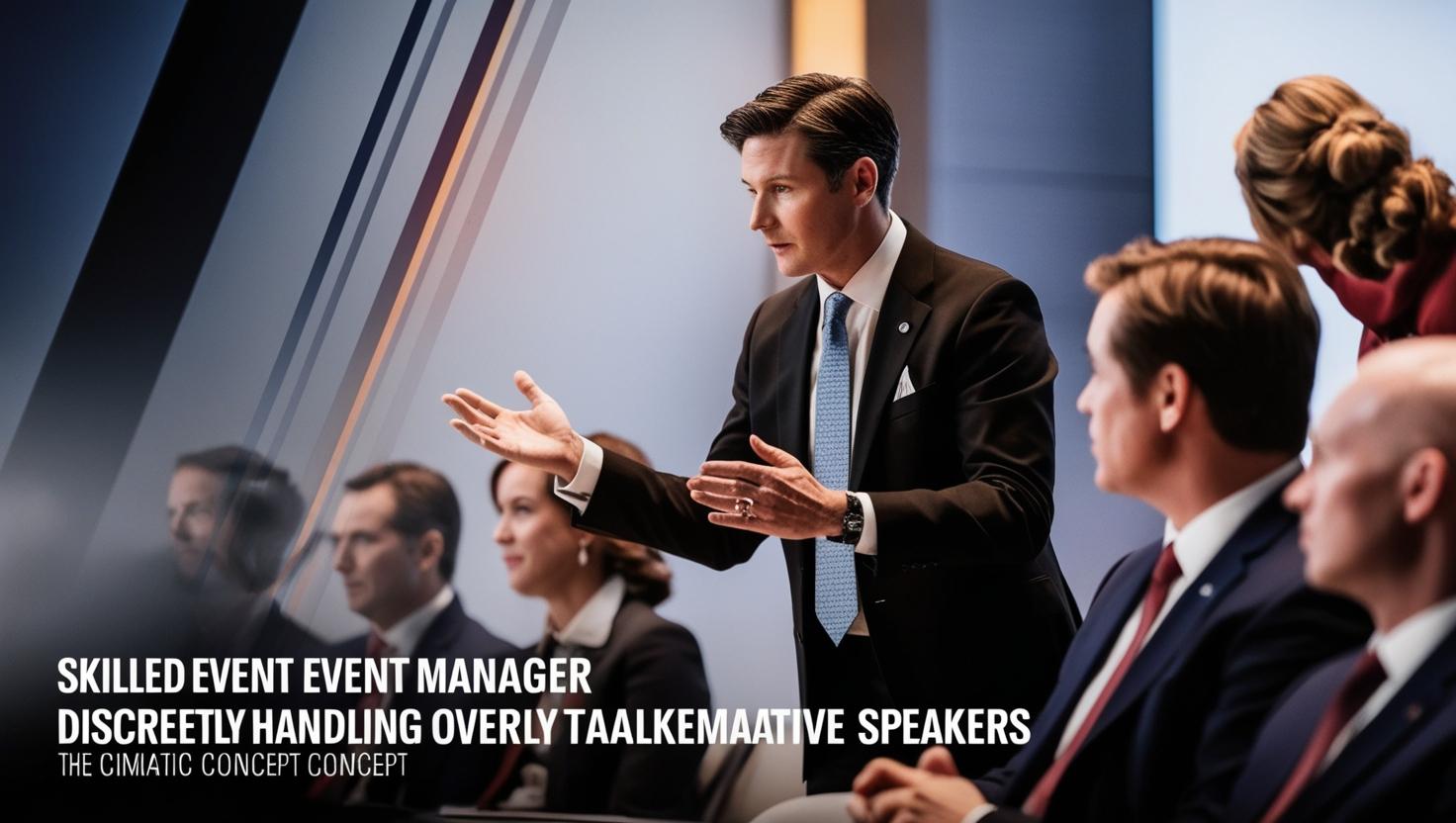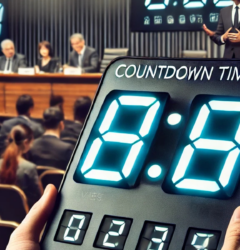- Email: [email protected]
- phone: +44 (0) 203 916 5117
23 May

At any event—be it a multi-speaker conference, a corporate meeting, or a high-stakes webinar—one recurring challenge event organizers face is managing speakers who go over their allotted time. These over-talking speakers can disrupt tightly packed agendas, delay subsequent sessions, and strain audience attention. However, the key to managing these moments lies not in confrontation but in preparation, professionalism, and subtle control mechanisms.
Modern event timing tools like a remote-controlled countdown timer or a stage timer for events have become essential for live productions, offering non-intrusive ways to manage speaker duration. By integrating timing expectations into session plans using techniques like countdown timer for addevent links and clear communication, organizers can ensure smooth transitions and respectful interventions.
In this blog, we will explore the common causes behind over-talking, how to set clear expectations with speakers, and ways to use tools like a speaker timer clock or a projection countdown timer to maintain flow without friction.
Understanding the Challenge of Over-Talking Speakers
Over-talking is a common issue at live events, particularly in scenarios where speakers are passionate, underprepared, or unfamiliar with the structure of timed presentations.
Why It Happens:
- Nervousness: Speakers may lose track of time due to anxiety.
- Lack of Practice: They may not have rehearsed within the assigned timeframe.
- Passion for Topic: Deep engagement may lead them to expand points without realizing.
- Poor Moderation: Without visible or audible timing cues, they may simply keep going.
Impact on the Event:
- Schedule Disruption: Other speakers and activities get delayed.
- Audience Fatigue: Prolonged sessions reduce engagement.
- Unfairness: Other speakers get less time or are forced to rush.
Understanding these root causes is critical to addressing them tactfully and avoiding any disrespect.
Setting Clear Expectations Before the Event
Preventing over-talking begins long before event day. It starts with setting clear expectations.
Pre-Event Communication:
- Share each speaker's time slot explicitly.
- Include buffer time between sessions but inform speakers that their presentation must conclude within their allotted window.
Use of Technology:
- Share add to event calendar invites that clearly indicate session start and end times.
- Use a countdown timer for addevent link in speaker briefing emails or digital run-sheets to reinforce how long they have.
Speaker Agreements:
- Include timing rules in contracts or speaker guidelines.
- Encourage a 5-minute wrap-up cue for every speaker.
Practice Runs:
- Host tech rehearsals or dry runs with the timer for speeches set at actual durations.
- This allows speakers to experience pacing and adjust content accordingly.
Setting expectations ensures there is no ambiguity and gives speakers a fair chance to prepare appropriately.
Using Silent Timers During the Event
Once the event is live, timing tools must be precise, visible, and discreet. A successful time management strategy includes multiple layers of visual and silent cues.
Technology in Action:
- Use a remote-controlled countdown timer that can be adjusted live from backstage.
- A stage timer for events placed near the podium or teleprompter gives speakers a clear view of time remaining.
- A projection countdown timer can be displayed on back screens visible only to speakers and moderators.
Benefits of Silent Timers:
- Avoids verbal interruptions.
- Respects the speaker's momentum and dignity.
- Helps speakers self-regulate without being publicly called out.
Color Coding and Signals:
- Green: ample time.
- Yellow: nearing limit.
- Red: time is up.
Timers should be synced with moderator and production teams for coordinated signaling.
Moderator and Host Techniques for Respectful Control
A skilled moderator is essential for enforcing speaker timing without making it awkward.
Moderator Scripts & Cues:
- "We’ll begin wrapping up in 2 minutes."
- "One final thought before we move on."
Non-Verbal Signals:
- Eye contact and hand gestures.
- Pointing to the speaker timer clock.
Polite Interventions:
- "In the interest of keeping us on schedule, let's conclude this segment."
- "Thank you for those insights. We'll now transition to the next speaker."
When handled tactfully, a firm but respectful approach is appreciated by both speakers and attendees.
Preparing Technically for Time Control
Behind-the-scenes readiness is just as important as on-stage strategies.
Timer Setup:
- Ensure all timing devices are tested and synced.
- Use devices like remote-controlled countdown timer that allow instant edits if sessions run late.
Operator Roles:
- Assign a team member to monitor the clock and communicate with hosts via headsets.
Timer Placement:
- Place a projection countdown timer at speaker eye level.
- Hide visible timers from the audience for a polished look.
Backup Plans:
- Have printed or manual cue cards.
- Have a stopwatch app on hand as a last resort.
Preparation minimizes the chance of technical or human error causing discomfort.
Managing Persistent Overruns Gracefully
Sometimes, despite all efforts, a speaker may exceed their time. Here's how to handle it without disrespect.
Soft Warnings:
- Reiterate wrap-up signals.
- Flash the stage timer for events with a red warning.
Moderator Involvement:
- Step in gently, saying, "We’ll continue this great discussion during the networking break."
Schedule Adjustments:
- If needed, trim Q&A or adjust break timing slightly.
Communication:
- Inform the next speaker of minor delays and thank them for understanding.
The key is to maintain flow and fairness without creating public awkwardness.
After-Event Review and Learning
Reflection leads to better practices in future events.
Gather Feedback:
- Ask speakers and moderators how effective the timing process was.
- Ask attendees if the sessions felt balanced and on time.
Analyze Timer Usage:
- Were cues noticed and respected?
- Did the timer for speeches help speakers prepare?
Tweak Guidelines:
- Include stronger messaging about time in future speaker kits.
- Provide timer access for future prep.
Template Improvements:
- Update your event planning documents to include timer placement and moderator scripting.
By turning feedback into action, you improve professionalism and pacing for future events.
Conclusion
Handling over-talking speakers respectfully is a skill rooted in preparation, communication, and discreet technology. With the right tools like a speaker timer clock or a remote-controlled countdown timer, supported by clear expectations and practiced moderators, event organizers can maintain punctuality without sacrificing decorum.
Visual aids like a projection countdown timer and proper use of add to event time indicators reinforce timing well before the event even starts. A thoughtful approach, combining silent cues and professional moderation, ensures your event runs on schedule and respects every participant’s voice—without needing to raise yours.
Ultimately, the balance of structure and empathy is what elevates event time management from a logistical challenge to a mark of professionalism.









Recent Comments